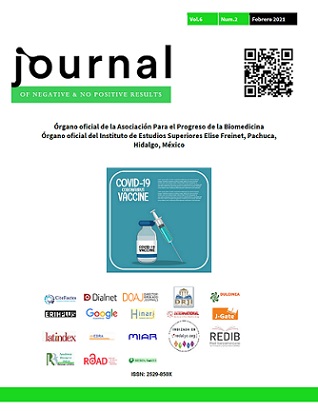Analysis of the relationship between Type 2 Diabetes Mellitus and obesity with cardiovascular risk factors
DOI:
https://doi.org/10.19230/jonnpr.3817Keywords:
obesity, diabetes mellitus type 2, diabesity, adipokines, cardiovascular riskAbstract
"Diabesity" is a booming concept that refers to individuals with type 2 diabetes mellitus and obesity. Both concepts are closely related.
A search of Web Of Science was carried out to carry out a bibliographic review with the aim of establishing the relationship between obesity, type 2 diabetes mellitus and cardiovascular risk factors.
Adipose tissue is an endocrine gland capable of secreting hormones, cytokines, and vasoactive substances. In obese individuals, this adipose tissue is dysfunctional, secreting certain adipokines such as leptin and adiponectin in an unusual way. So much so, that in obese individuals undergoing bariatric surgery, the adiponectin / leptin ratio has been reversed. Furthermore, in an obesogenic environment, adipose tissue displays a proinflammatory phenotype, which helps perpetuate the process of insulin resistance and the consequent development of prediabetes and type 2 diabetes mellitus.
It is important to determine new therapeutic targets for diabesity, such as the GPS2 transcription factor, which shows a decrease in its levels in obese subjects, which predisposes to a pro-diabetic phenotype.
Mi-483-5p has recently been shown to be expressed in relevant tissues of diabetes and cardiovascular disease, which predicts its potential as a blood biomarker for these diseases.
In conclusion, this review aims to emphasize the importance of controlling cardiovascular risk factors, such as obesity, to prevent the subsequent development of a disease closely related to it, such as type 2 diabetes.
Downloads
References
Schmidt AM. Highlighting Diabetes Mellitus: The Epidemic Continues. Arterioscler Thromb Vasc Biol 2018;38(1):E1–8.
Egocheaga MI, Flores I, Sanchis C, Pepió JM, Paja E, Nevado A, Iglesias JM, Domínguez, M, Ureña T, Bonet A, Dalfó A, Martín E. Estudio Steno2. Gaede P Vedel P Larsen N Jensen G Parving HH Pedersen O Multifactorial Interv Cardiovasc Dis Patients Type 2 Diabetes N Engl J Med 2003 348 383- 393
Castell Abat C, Lloveras Vallès G. El estudio prospectivo inglés sobre diabetes (UKPDS): importantes respuestas, pero persisten muchas preguntas. Endocrinol Nutr 1999;46(2):53.
Drareni K, Ballaire R, Barilla S, et al. GPS2 Deficiency Triggers Maladaptive White Adipose Tissue Expansion in Obesity via HIF1A Activation. Cell Rep 2018;24(11):2957-+.
Kahn BB. Adipose Tissue, Inter-Organ Communication, and the Path to Type 2 Diabetes: The 2016 Banting Medal for Scientific Achievement Lecture. Diabetes 2019;68(1):3–14.
Bonamichi BDSF, Lee J. Unusual Suspects in the Development of Obesity-Induced Inflammation and Insulin Resistance: NK cells, iNKT cells, and ILCs. Diabetes Metab J 2017;41(4):229–50.
Villarroya F, Cereijo R, Gavalda-Navarro A, Villarroya J, Giralt M. Inflammation of brown/beige adipose tissues in obesity and metabolic disease. J Intern Med 2018;284(5):492–504.
Landecho MF, Tuero C, Valenti V, Bilbao I, de la Higuera M, Fruhbeck G. Relevance of Leptin and Other Adipokines in Obesity-Associated Cardiovascular Risk. Nutrients 2019;11(11):2664.
Eckel J. Myokines in metabolic homeostasis and diabetes. Diabetologia 2019;62(9):1523–8.
Unamuno X, Izaguirre M, Gomez-Ambrosi J, et al. Increase of the Adiponectin/Leptin Ratio in Patients with Obesity and Type 2 Diabetes after Roux-en-Y Gastric Bypass. Nutrients 2019;11(9):2069.
Owei I, Umekwe N, Provo C, Wan J, Dagogo-Jack S. Insulin-sensitive and insulin-resistant obese and non-obese phenotypes: role in prediction of incident pre-diabetes in a longitudinal biracial cohort. Bmj Open Diabetes Res Care 2017;5(1):e000415.
Gallo W, Esguerra JLS, Eliasson L, Melander O. miR-483-5p associates with obesity and insulin resistance and independently associates with new onset diabetes mellitus and cardiovascular disease. Plos One 2018;13(11):e0206974.
Published
Issue
Section
License
All accepted originals remain the property of JONNPR. In the event of publication, the authors exclusively transfer their rights of reproduction, distribution, translation and public communication (by any sound, audiovisual or electronic medium or format) of their work. To do so, the authors shall sign a letter transferring these rights when sending the paper via the online manuscript management system.
The articles published in the journal are freely used under the terms of the Creative Commons BY NC SA license, therefore.
You are free to:
Share — copy and redistribute the material in any medium or format
Adapt — remix, transform, and build upon the material
The licensor cannot revoke these freedoms as long as you follow the license terms.
Under the following terms:
Attribution — You must give appropriate credit, provide a link to the license, and indicate if changes were made. You may do so in any reasonable manner, but not in any way that suggests the licensor endorses you or your use.
NonCommercial — You may not use the material for commercial purposes.
ShareAlike — If you remix, transform, or build upon the material, you must distribute your contributions under the same license as the original.
No additional restrictions — You may not apply legal terms or technological measures that legally restrict others from doing anything the license permits.

This work is licensed under a Creative Commons Attribution-NonCommercial-ShareAlike 4.0 International License

























